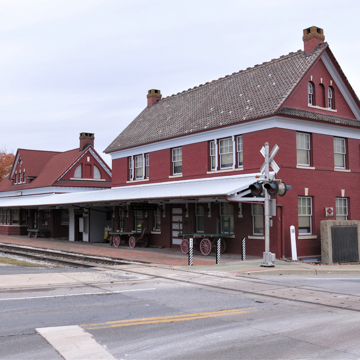Instrumental to the development of Union Bridge was the Western Maryland Railway (WMR) that arrived in Union Bridge in 1862. Replacing the original shop facilities, the current buildings comprise a separate brick passenger station and office building joined by a frame baggage room, breezeway, and bracketed sheltering overhang. Once completed, the office building became the new WMR headquarters, which was moved here from Baltimore as the railway progressed into Pennsylvania and West Virginia. The WMR was central to the economy of Carroll County, providing additional markets for its farm produce and manufactured goods. Light industries developed along its tracks, such as the extant c. 1883 grain elevator and the cement plant that began in 1910 as Tidewater Portland Cement Company (40 N. Main Street).
Gott’s design for the station and office buildings reflects the fashion for classicism. They were built by local contractor and carpenter Joseph Wolfe and then-partner John Rakestraw, using the “best hard run of kiln Berlin Junction [Pennsylvania] bricks” and white Baltimore County limestone “free from blue streaks.” As the railway reduced services to light freight only, the Western Maryland Railway Historical Society was formed in 1967, now maintaining a museum in the former office building.















